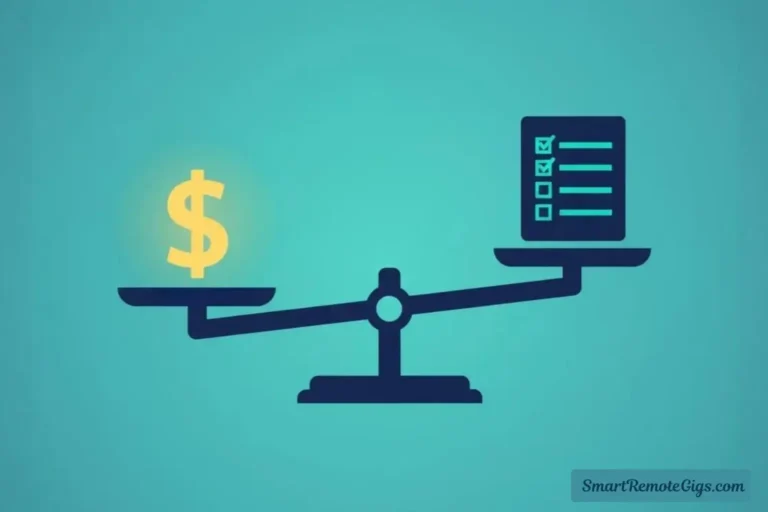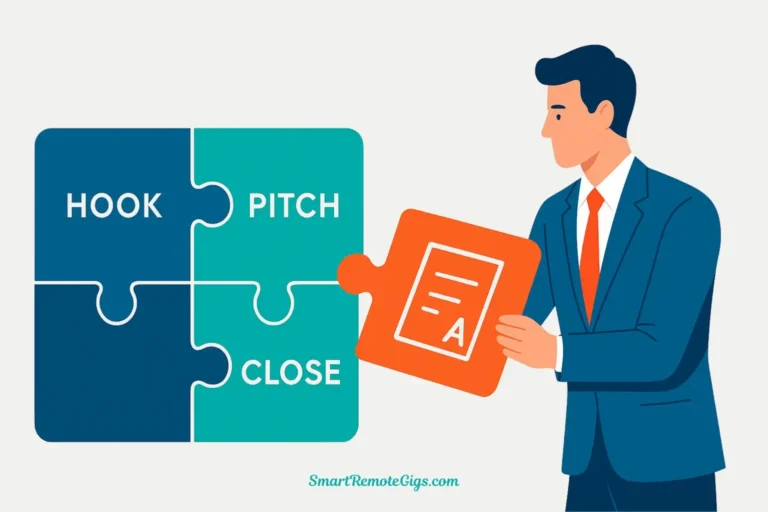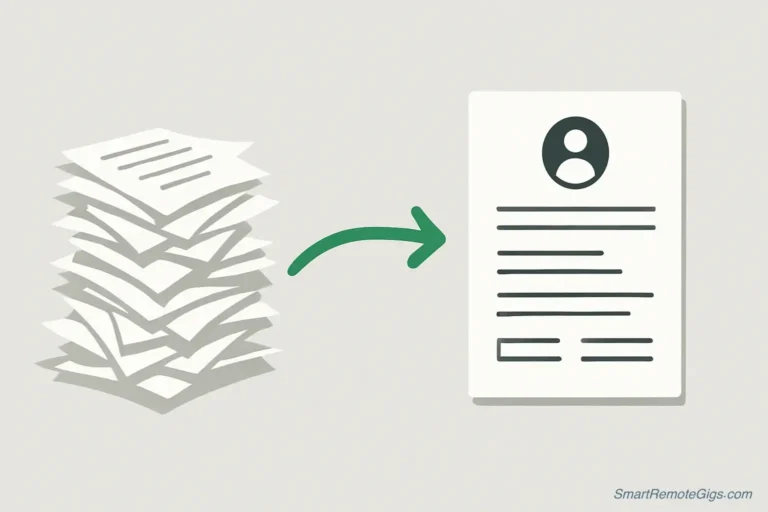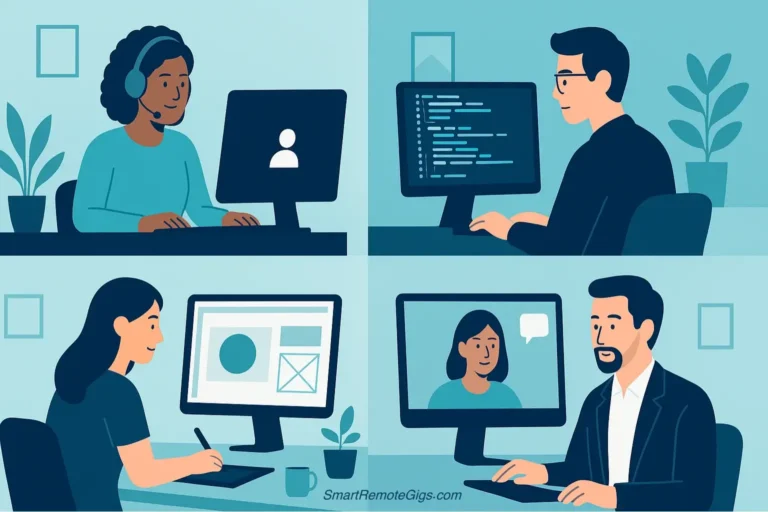You’ve polished your resume, crafted a compelling cover letter, and landed the interview. Now comes the moment that makes even experienced project managers sweat: the actual conversation with a hiring manager you’ve never met, conducted through a screen, where every word and facial expression carries extra weight.
Remote PM interviews present unique challenges that in-person interviews don’t. Hiring managers can’t rely on casual pre-interview small talk or post-interview hallway conversations to gauge your personality. They can’t observe how you interact with their team over lunch. Everything they learn about you comes from structured questions in a compressed timeframe, often with the added complexity of video lag, awkward silences, and the pressure to over-communicate through a screen.
The good news? Remote interviews follow predictable patterns. Hiring managers ask specific types of questions designed to assess whether you can succeed without the structure of an office environment. Once you understand why they’re asking each question and what they’re really evaluating, you can prepare strategic answers that showcase your remote work competency alongside your project management skills.
This guide breaks down the 15 most common remote project manager interview questions you’ll encounter in 2025, organized by category. For each question, we’ll explain the hiring manager’s underlying concern, provide a formula for structuring your answer, and show you a strong example response. By the end, you’ll have a complete framework for answering any remote PM interview question with confidence, even ones that catch you off guard.
Understanding the Remote Interview Difference
Before diving into specific questions, it’s worth understanding what makes remote PM interviews distinct from traditional ones. Hiring managers evaluating remote candidates are assessing three additional competencies beyond standard PM skills:
Asynchronous communication ability: Can you convey complex information clearly in writing? Do you proactively document decisions and share context without being asked?
Self-direction and accountability: Will you deliver results without daily in-person supervision? Can you identify and solve problems independently before they escalate?
Remote collaboration skills: Can you build relationships and influence stakeholders through screens? Do you understand the tools and workflows that make distributed teams effective?
Every question in a remote PM interview—even seemingly generic ones—is partially evaluating these three dimensions. Keep this in mind as you prepare your answers.
Foundational Questions: Setting the Stage
These opening questions establish your narrative and help the interviewer understand your background and motivations. While they seem straightforward, they’re opportunities to immediately differentiate yourself and establish remote work credibility.
Question 1: “Tell me about yourself.”
Why they ask this: This isn’t small talk. Interviewers use this open-ended question to assess your communication skills, understand your career narrative, and see if you can distill complex information concisely—all critical remote PM competencies. They’re also listening for whether you naturally emphasize relevant experience or ramble through irrelevant details.
Formula for your answer:
- Present: Current role and primary responsibility (1 sentence)
- Past: Relevant background that led you here (2-3 sentences)
- Future: Why this role interests you and what you bring (1-2 sentences)
- Total time: 60-90 seconds maximum
Strong example:
“I’m currently a project manager at TechCorp, where I coordinate cross-functional product releases for our B2B SaaS platform, managing timelines and stakeholder communication across engineering, design, and customer success teams. I started my career in customer support, which taught me to anticipate user needs and communicate complex technical concepts clearly—skills that translated naturally into project coordination when I moved into an operations role three years ago. I earned my CAPM certification last year to formalize my PM knowledge, and I’ve been specifically focused on mastering remote collaboration since our team went fully distributed in 2023. What excites me about this role at your company is the opportunity to apply my experience coordinating distributed teams to help scale your operations as you expand into new markets.”
Why it works: This answer is structured, concise, and naturally weaves in remote work experience without forcing it. The narrative arc makes sense (support → operations → PM) and the candidate connects their background to the specific opportunity.
Question 2: “Why are you interested in this remote role specifically?”
Why they ask this: Interviewers want to confirm you’re interested in the role itself, not just the convenience of working from home. They’re screening out candidates who view remote work as a perk rather than a strategic work arrangement that requires different skills. They also want to ensure you understand the company’s specific needs and aren’t mass-applying.
Formula for your answer:
- Company-specific interest: Reference something specific about their company, product, or mission (shows research)
- Role-specific interest: Explain what about this particular role excites you (shows genuine interest)
- Remote work competency: Frame remote work as an advantage that enables better outcomes, not as personal convenience
Strong example:
“I’ve been following your company’s growth since your Series A announcement last year, and I’m impressed by how you’ve built a fully distributed team while maintaining such strong customer satisfaction scores. What draws me to this role specifically is the opportunity to establish project management processes during a scaling phase—I love the challenge of building systems that can grow with an organization rather than inheriting rigid processes. Having coordinated remote projects for the past two years, I’ve found that distributed teams actually enable more thoughtful, asynchronous decision-making when you implement the right communication structures. I’m excited to bring that perspective to help your team scale efficiently without sacrificing the collaborative culture your Glassdoor reviews consistently highlight.”
Why it works: This answer demonstrates genuine research, connects to the specific role’s challenges, and frames remote work as a professional competency rather than personal preference.
Question 3: “Walk me through your project management approach.”
Why they ask this: This question assesses whether you have a structured methodology or if you’re winging it. They’re evaluating your ability to articulate process, use PM terminology appropriately, and adapt your approach to different contexts. For remote roles, they’re particularly listening for mentions of documentation, asynchronous communication, and distributed team considerations.
Formula for your answer:
- Framework: Name your general approach (Agile, Waterfall, hybrid) and why it fits your context
- Key phases: Walk through your typical project lifecycle in 3-4 stages
- Remote adaptations: Naturally mention how you’ve adapted for distributed teams
- Flexibility: Acknowledge that you adjust based on project needs
Strong example:
“I typically use a hybrid approach that adapts Agile principles for cross-functional projects. I start every project with a kickoff phase where I align stakeholders on objectives, success metrics, and communication norms—for remote teams, this is where I establish our async communication guidelines and decision-making protocols upfront. During execution, I run two-week sprints with clear deliverables, using a combination of async check-ins via project management tools and synchronous touchpoints for problem-solving that requires real-time discussion. I maintain living documentation in Confluence so anyone across time zones can get project context without waiting for me to respond. Throughout the project, I proactively surface risks and present mitigation options before issues become crises. That said, I adjust this framework based on project complexity—a simple website update doesn’t need the same structure as a nine-month product launch.”
Why it works: This answer demonstrates methodology without being rigid, uses appropriate PM terminology, and naturally incorporates remote-specific practices (async communication, documentation, time zones) without being prompted.
Situational & Behavioral Questions: Proving Your Experience
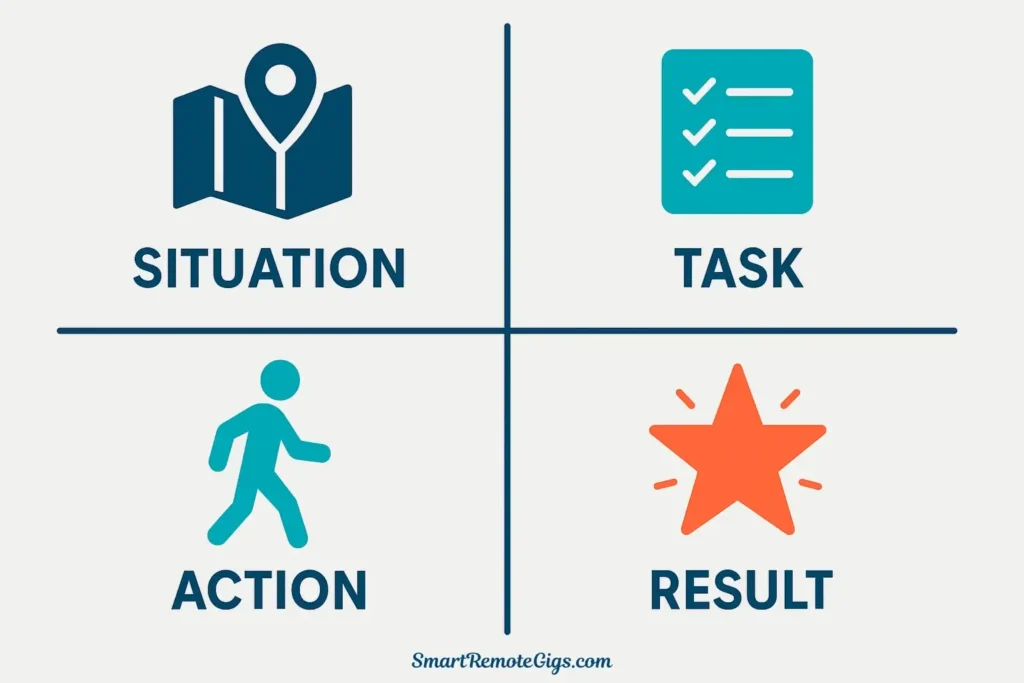
Behavioral questions are where interviewers dig into your real experience. These behavioral PM interview questions always start with phrases like “Tell me about a time…” or “Describe a situation where…” They’re using your past behavior to predict your future performance.
The STAR method (Situation, Task, Action, Result) is the gold standard for structuring behavioral interview answers. Here’s how to use it effectively:
- Situation: Set the scene in 1-2 sentences (What was the context?)
- Task: Explain your specific responsibility (What were you asked to do?)
- Action: Describe what YOU did, using “I” not “we” (What steps did you take?)
- Result: Share the measurable outcome (What happened because of your actions?)
For more detailed guidance on the STAR method, Harvard Business Review’s interview guide provides excellent examples and common pitfalls to avoid.
Question 4: “Tell me about a time a remote project was failing. How did you turn it around?”
Why they ask this: Every project hits obstacles. Interviewers want to see how you respond under pressure, solve problems proactively, and communicate bad news effectively. For remote roles, they’re especially interested in whether you can identify and address issues without in-person conversations to read the room.
Formula for your answer (STAR):
- Situation: Briefly describe the project and the specific failure point
- Task: Explain what needed to happen to save the project
- Action: Walk through your specific interventions (communication, timeline adjustments, resource allocation)
- Result: Quantify the outcome and what you learned
Strong example:
(Situation) “In my previous role, I was managing a website redesign that fell three weeks behind schedule due to scope creep and misaligned stakeholder expectations. The marketing team expected launch before a major conference, but our development team was buried in unexpected revisions.”
(Task) “My task was to get us back on track without compromising quality or burning out the team.”
(Action) “I immediately called an emergency stakeholder meeting to realign on must-have versus nice-to-have features, documenting every decision in a shared decision log so distributed team members could review asynchronously. I worked with the dev lead to create a revised timeline that prioritized conference-critical features for phase one, then scheduled the remaining features for phase two post-conference. I also implemented daily 15-minute async video updates where each team member recorded progress and blockers, which eliminated the need for daily meetings and gave our UK-based designer flexibility to contribute during his working hours.”
(Result) “We launched phase one two days before the conference with all critical features, and the marketing team reported a 34% increase in lead generation compared to the previous year’s conference. The experience taught me that transparent communication and ruthless prioritization are your best tools when projects go sideways.”
Why it works: This answer uses clear STAR structure (now explicitly labeled in the first behavioral example to help you learn the pattern), quantifies the result (34% increase), includes remote-specific details (asynchronous updates, distributed team members), and shows both problem-solving and learning.
Question 5: “Describe a time you had to manage conflict between team members you’ve never met in person.”
Why they ask this: Conflict is inevitable on any project, but it’s harder to detect and resolve on remote teams where you can’t observe body language or overhear frustrated conversations. Interviewers want to know if you address conflict directly, facilitate resolution effectively, and prevent issues from festering in distributed environments.
Formula for your answer (STAR):
- Situation: Describe the conflict briefly without assigning blame
- Task: Explain what you needed to accomplish (resolution, maintained relationships, kept project moving)
- Action: Detail your intervention steps, focusing on facilitation and communication
- Result: Share the outcome for both the relationship and the project
Strong example:
“On a recent product launch, our lead developer and UX designer had a fundamental disagreement about implementation approach. The developer wanted to reuse existing components for speed, while the designer insisted on custom elements for the user experience. The tension was escalating in Slack, and work had essentially stopped on that feature. I needed to resolve this quickly without damaging either relationship or compromising the project. I scheduled a video call with both of them where I first asked each person to explain their perspective without interruption while I took notes. I then restated each viewpoint to ensure I understood correctly and asked clarifying questions about their core concerns—I learned the developer was worried about timeline, while the designer was concerned about brand consistency. I proposed we prototype both approaches in a 48-hour sprint and gather stakeholder feedback to make a data-driven decision. Both agreed, and after the sprint, stakeholders actually preferred a hybrid approach neither had initially suggested. The feature launched on time, and both team members told me later they appreciated the structured resolution process. Since then, I’ve used this ‘perspective → prototype → decide’ approach for other design-technical disagreements.”
Why it works: The answer shows emotional intelligence, structured problem-solving, and a resolution that preserved relationships. The candidate also demonstrates learning by explaining how they’ve applied this approach to future situations.
Question 6: “Tell me about a time you missed a deadline. What happened?”
Why they ask this: This question tests your honesty, accountability, and crisis management. Everyone misses deadlines occasionally—what matters is how you handle it. For remote roles, they want to know if you communicate problems proactively or let them surface at the last minute.
Formula for your answer (STAR):
- Situation: Honestly describe the missed deadline (don’t make excuses)
- Task: Explain what you were trying to accomplish and why it mattered
- Action: Detail how you communicated the delay, managed stakeholders, and prevented future occurrences
- Result: Share what happened and what you learned
Strong example:
“Early in my PM career, I underestimated the complexity of integrating a third-party API for a client portal project and committed to a deadline without adequate buffer. Two days before launch, our developer discovered the API had undocumented rate limits that would break our implementation. I immediately informed my manager and the client stakeholders via email with a clear explanation of the issue, a revised timeline with specific milestones, and the mitigation steps we were taking. I worked with our developer to implement a queuing system and caching layer, and I personally handled all client communication to shield my team from the pressure. We ultimately launched five days late, but the client appreciated the transparent communication and the fact that we over-delivered on performance when we did launch. That experience taught me to always build timeline contingency for technical integrations and to communicate problems the moment I become aware of them, not when I’m certain I can’t fix them. Since then, I’ve never missed a deadline because I now factor realistic buffers into all my estimates and implement weekly risk reviews specifically to catch issues early.”
Why it works: This answer demonstrates accountability (doesn’t blame others), proactive communication (told stakeholders immediately), and learning (specific changes to prevent recurrence). The candidate also shows they understand remote work requires over-communication about problems.
Question 7: “How do you prioritize when you have multiple urgent requests from different stakeholders?”
Why they ask this: Project managers constantly juggle competing priorities. This question assesses your decision-making framework, stakeholder management skills, and whether you can make tough calls independently—critical for remote work where you can’t quickly huddle with your boss for direction.
Formula for your answer:
- Framework: Explain your prioritization methodology (impact vs. effort, business value, risk assessment)
- Communication: Describe how you gather information and align stakeholders
- Decision: Walk through a specific example of making a tough prioritization call
- Transparency: Explain how you communicate decisions and manage expectations
Strong example:
“I use an impact-versus-effort framework combined with business priority alignment. When multiple urgent requests come in, I first assess each against our current business objectives and ask clarifying questions to understand the true urgency versus perceived urgency. I recently had three stakeholders all requesting ‘urgent’ attention: marketing needed landing page updates for a campaign, customer success needed a feature fix affecting one enterprise client, and sales needed demo environment updates. I scheduled quick 15-minute calls with each stakeholder to understand their deadlines and the consequences of delays. I learned marketing’s campaign didn’t launch for two weeks, the customer success issue was causing daily friction with a $200K account, and sales had a demo in three days. I prioritized the customer success fix first because of the revenue risk, sales demo prep second because of the imminent deadline, and marketing updates last since we had time. I sent all three stakeholders a brief email explaining my prioritization rationale and revised timelines, which prevented any confusion or frustration. The key is transparent communication about why I’m making the prioritization decision, not just what I’m prioritizing.”
Why it works: This answer demonstrates a structured decision-making process, stakeholder empathy, and transparent communication—all critical for remote PM success.
Question 8: “Describe a situation where you had to influence a decision without having formal authority.”
Why they ask this: Project managers rarely have direct authority over their team members. This question tests your ability to lead through influence, build consensus, and drive outcomes through relationships rather than hierarchy—skills that are harder to demonstrate remotely.
Formula for your answer (STAR):
- Situation: Set up the context and the decision that needed to be made
- Task: Explain why you needed to influence this decision despite lacking authority
- Action: Detail your influence strategy (data, relationships, framing, stakeholder alignment)
- Result: Share the outcome and what you learned about influence
Strong example:
“In my current role, I noticed our team was wasting significant time in redundant status meetings across projects. I wanted to shift to an asynchronous status update model, but I had no authority to change how other PMs ran their projects. I needed to build consensus among five PMs and our director. I started by gathering data: I tracked how much time we collectively spent in status meetings over two weeks and calculated it was about 15 hours per week across the team. I then created a one-page proposal for an async status update system using Notion, including a pilot plan where we’d try it for one sprint on my project and measure the time savings. Instead of presenting this to the full group initially, I first approached two PMs individually who I knew were most open to change, shared the data, and asked for their input on the proposal. They helped me refine the idea and agreed to co-sponsor it. When we presented to the full group with three PMs supporting it, the director was more receptive. We ran the pilot, saved 12 hours per week across projects, and the director mandated the approach team-wide. This taught me that influence is about building coalitions, using data to support your case, and making it easy for people to say yes by reducing risk through pilots.”
Why it works: This answer shows strategic thinking, relationship-building, and data-driven influence—exactly what remote PMs need when they can’t rely on hallway conversations to build support.
Remote-Specific Questions: Testing Your Async & Communication Skills
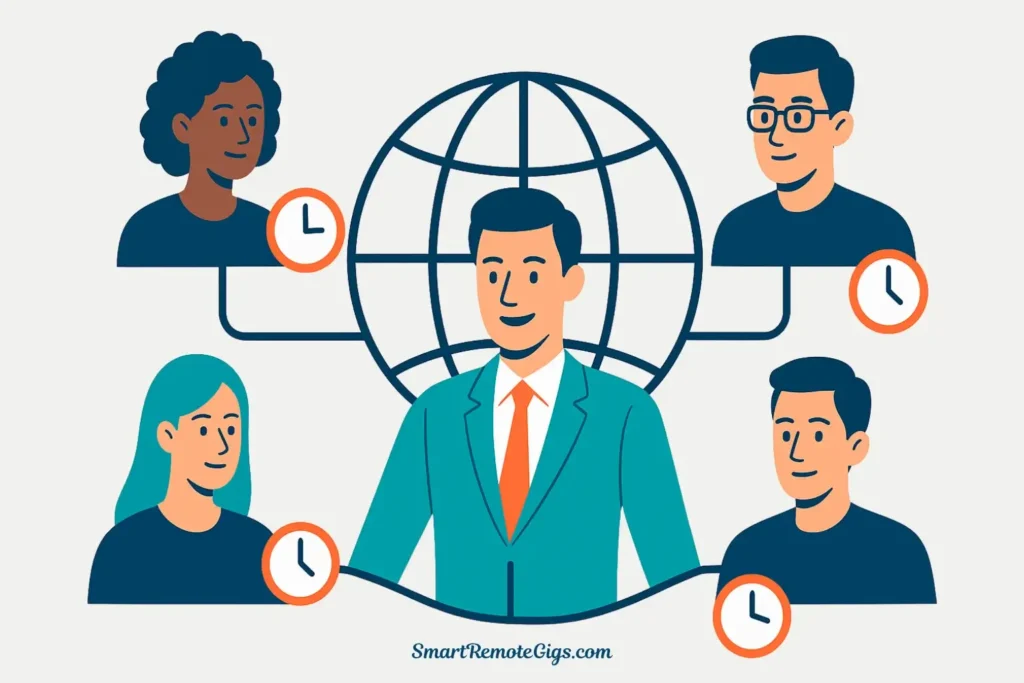
These situational remote PM questions specifically target your understanding of distributed work challenges. They’re evaluating whether you’ve truly mastered remote collaboration or if you’re just hoping to figure it out on the job.
Question 9: “How do you build team rapport and culture on a fully distributed team?”
Why they ask this: Remote teams can feel isolating and transactional. Hiring managers want to know if you can create connection and psychological safety without the benefit of shared lunches, coffee chats, or casual hallway conversations. This is especially critical for PMs who need to facilitate collaboration across functions.
Formula for your answer:
- Intentionality: Explain that remote culture requires deliberate effort, not chance encounters
- Specific practices: Share 3-4 concrete tactics you’ve used (virtual coffee chats, team rituals, recognition practices)
- Results: Describe the impact on team dynamics or project outcomes
- Individual variation: Acknowledge that different team members need different approaches
Strong example:
“I’ve learned that remote team culture doesn’t happen accidentally—it requires the same intentionality you bring to project planning. I use several specific practices. First, I start every project with a team kickoff that includes a ‘working styles’ discussion where everyone shares their communication preferences, time zone, typical working hours, and one personal interest. This creates baseline connection and sets norms upfront. Second, I schedule optional ‘virtual coffee’ sessions once every two weeks where we don’t discuss work at all—it’s purely social, and participation averages about 70%. Third, I make a point to recognize individual contributions publicly in our Slack channel, which creates positive momentum and models appreciation. Fourth, I maintain a team ‘wins’ document where anyone can add project successes or personal milestones, which we review in our monthly retrospectives. On my last project, our team engagement survey scores increased by 23% over six months, and three team members specifically cited feeling more connected to the team despite being fully remote. The key is consistency and genuinely caring about people as humans, not just resources.”
Why it works: This answer provides specific, actionable tactics that demonstrate real experience. The quantified result (23% engagement increase) proves these practices work, and the acknowledgment that this requires intentional effort shows maturity.
Question 10: “Describe your process for managing stakeholders across multiple time zones.”
Why they ask this: Time zone management is one of the most concrete challenges of remote work. This question tests whether you understand asynchronous communication, can structure workflows to accommodate distributed stakeholders, and have practical experience coordinating across geographies. If you need deeper strategies for this, see our guide on mastering asynchronous communication for remote PMs.
Formula for your answer:
- Documentation: Explain your approach to written communication and decision-making
- Meeting strategy: Describe how you minimize synchronous requirements
- Tools: Mention specific tools you use for async collaboration
- Example: Share a specific project where you successfully managed time zone complexity
Strong example:
“Managing across time zones requires shifting from synchronous-first to asynchronous-first thinking. My core practice is documentation-driven decision-making: I create comprehensive project briefs, maintain living decision logs, and write detailed status updates that stakeholders can review on their schedule. For meetings that must be synchronous, I rotate meeting times to share the burden of off-hours calls—if we have stakeholders in San Francisco, New York, and London, I schedule one meeting at 8am Pacific (good for NY and London) and the next at 4pm Pacific (better for SF but challenging for London). I record all meetings and share timestamped notes within two hours. I use Notion for project documentation, Loom for async video updates, and Slack for quick clarifications with clear response-time expectations. On my most recent project spanning teams in Seattle, Austin, and Berlin, I maintained a 24-hour decision turnaround by structuring questions so they could be answered asynchronously with full context. We delivered on time with 95% stakeholder satisfaction despite never having all stakeholders in a meeting together. The key is recognizing that time zones are actually an advantage—you can essentially have work happening around the clock if you structure it properly.”
Why it works: This answer demonstrates deep understanding of async work principles, provides specific tools and tactics, includes a real example with results, and reframes time zones as an advantage rather than just a challenge.
Question 11: “What project management tools are you most comfortable with, and how do you decide which to use?”
Why they ask this: Remote work is tool-dependent. Hiring managers want to know if you’re proficient with standard PM tools, can learn new ones quickly, and understand that tool selection is strategic, not random. They’re also screening for candidates who might struggle to adapt to their specific tech stack.
Formula for your answer:
- Core tools: Name 3-4 PM tools you have strong experience with
- Decision framework: Explain how you choose tools based on project needs
- Adaptability: Acknowledge you can learn new tools quickly
- Example: Share a specific instance where you selected or switched tools and why
Strong example:
“I’m most experienced with Asana and Jira for task management, Confluence for documentation, and Miro for collaborative planning sessions. That said, I choose tools based on team needs and project complexity, not personal preference. For straightforward projects with non-technical stakeholders, I prefer Asana because of its intuitive interface and flexibility. For technical projects with engineering-heavy teams, Jira makes more sense because it integrates with development workflows. I always prioritize tools the team is already using over introducing something new unless there’s a clear efficiency gain. For example, on a recent project I inherited, the team was using a complex spreadsheet to track tasks, which was causing missed deadlines because it wasn’t updating in real-time. I migrated us to Asana and spent time training the team on it, which reduced our task confusion by about 40% based on retrospective feedback. I’m also comfortable learning new tools quickly—I taught myself ClickUp in a weekend when joining a new team that used it. The tool matters less than ensuring everyone knows how to use it effectively and that it supports async collaboration.”
For a deeper comparison of PM tools and when to use each, check out our guide: Asana vs. Jira: Which Remote PM Tool Wins in 2025?
Why it works: This answer demonstrates tool proficiency without being dogmatic, shows strategic thinking about tool selection, includes evidence of adaptability, and emphasizes team needs over personal preference.
Question 12: “How do you ensure remote team members stay accountable without micromanaging?”
Why they ask this: This is a fundamental tension in remote PM work. Hiring managers want to know if you can maintain visibility and accountability while respecting autonomy and avoiding surveillance-style management. This question tests your trust in teams, your systems thinking, and your communication approach.
Formula for your answer:
- Systems over surveillance: Explain that accountability comes from clear expectations and transparent progress tracking
- Specific practices: Share how you set expectations, track progress, and identify issues early
- Trust: Emphasize that you default to trusting team members
- Example: Describe a specific situation where your approach successfully maintained accountability
Strong example:
“I believe accountability comes from clarity, not surveillance. My approach has three components. First, I establish crystal-clear expectations upfront: what’s the deliverable, what does done look like, when is it due, and who needs to be informed. I document this in our project management tool so there’s a single source of truth. Second, I implement lightweight check-in systems that provide visibility without requiring constant updates—typically async status updates twice per week where each person shares progress, blockers, and plans. This takes five minutes but surfaces issues early. Third, I have regular one-on-one conversations where I ask ‘What’s getting in your way?’ rather than ‘Why isn’t this done?’ On my last project, one developer consistently delivered quality work but missed several interim milestones. Instead of escalating immediately, I asked what was happening. I learned he was managing urgent production bugs that weren’t visible to me. We adjusted his timeline and brought in another developer for the production issues. He delivered the project work on the revised timeline, and he told me later he appreciated that I asked questions before assuming he was slacking. Trust is the foundation—most people want to do good work, and if they’re not, there’s usually a reason you can address.”
Why it works: This answer balances structure with empathy, provides a clear framework that’s replicable, and demonstrates the candidate understands that accountability and trust aren’t opposing forces.
Question 13: “Tell me about your remote work setup and how you stay productive.”
Why they ask this: This seemingly casual question actually tests whether you take remote work seriously. Hiring managers want to know if you have a professional workspace, understand boundaries, and have systems to maintain focus and productivity. They’re screening out people who’ll “work from the couch” and struggle with self-management.
Formula for your answer:
- Physical setup: Briefly describe your dedicated workspace
- Productivity systems: Share specific habits or routines that keep you focused
- Communication boundaries: Explain how you balance availability with deep work
- Results orientation: Frame this around outcomes, not just hours logged
Strong example:
“I have a dedicated home office with a proper desk, external monitor, and good lighting—I learned early that trying to work from the couch doesn’t work for me. I treat my workday with the same structure I’d have in an office: I start at 8am, take a proper lunch break, and end around 5pm unless there’s a time zone consideration. For productivity, I use time-blocking to protect deep work time—I block 9am-11am daily as ‘no meeting time’ for focus work, and I use the Pomodoro technique for complex tasks that require sustained concentration. I keep Slack notifications on during working hours but set clear boundaries by updating my status when I’m in focus mode. I also maintain a daily task list where I identify my top three priorities each morning, which keeps me focused on outcomes rather than just activity. In my current role, this approach has helped me maintain a consistent track record of delivering projects on time while still being responsive to my team—my manager has specifically noted my balance of availability and productivity in my last two performance reviews.”
Why it works: This answer demonstrates professionalism (dedicated workspace), concrete productivity systems (time-blocking, Pomodoro), healthy boundaries (status updates, structured day), and connects to actual results (manager feedback, on-time delivery).
Question 14: “How do you handle a situation where a team member isn’t responding to messages for several days?”
Why they ask this: Communication challenges are amplified in remote settings. This question tests your problem-solving approach, escalation judgment, and whether you can balance persistence with respect for boundaries. It’s also testing your emotional intelligence and crisis management.
Formula for your answer:
- Initial approach: Explain your first attempts to reach them through multiple channels
- Concern vs. frustration: Show you consider legitimate reasons for silence
- Escalation path: Detail when and how you’d involve others
- Documentation: Mention tracking communication attempts
- Prevention: Describe how you’d prevent this situation proactively
Strong example:
“I’d start by trying different communication channels—if they’re not responding to Slack, I’d try email, then a text message if I have their number, since they might be having technical issues. I’d keep my messages concerned and supportive, not accusatory: ‘Hey, I haven’t heard from you in a few days and wanted to make sure everything’s okay. Can you let me know your status when you get a chance?’ I give it 24 hours between attempts. If I don’t hear back after three attempts over two days, I’d involve my manager and potentially HR depending on the situation, because at that point there might be a personal emergency or health issue that requires organizational support. I’d document my communication attempts with timestamps in case there are future questions. That said, I try to prevent this situation proactively by establishing clear communication expectations during project kickoff—we agree on expected response times for different channels and what to do if someone needs to go dark for any reason. I also maintain regular check-in rhythms so if someone starts to disengage, I notice early rather than discovering it when something’s urgent.”
Why it works: This answer shows empathy (considers legitimate reasons), clear escalation judgment (knows when to involve others), and proactive thinking (prevention strategies). It demonstrates maturity and emotional intelligence.
Question 15: “What questions do you have for us?”

Why they ask this: This isn’t a throwaway question. Your questions reveal what you prioritize, whether you’ve researched the company, and how seriously you’re considering the role. For remote positions, strong candidates ask about team dynamics, communication practices, and distributed work culture—not just benefits and PTO.
Formula for your answer:
- Prepare 5-6 questions (you probably won’t ask all)
- Focus on role success, team dynamics, and company culture
- Avoid questions easily answered by their website
- Include at least one remote-specific question
Strong questions to ask:
- “What does success look like for this role in the first 90 days?” (Shows you’re focused on outcomes)
- “How does your team handle asynchronous decision-making when stakeholders are spread across time zones?” (Tests their remote maturity)
- “Can you describe a recent project where this team collaborated particularly well? What made it successful?” (Reveals team dynamics)
- “What are the biggest challenges facing your PM team right now?” (Shows you want to understand problems, not just sell yourself)
- “How do you support professional development and mentorship for remote team members?” (Demonstrates long-term thinking)
- “What’s your approach to remote team culture and connection?” (Tests if they’ve thought seriously about remote work)
Why these work: These questions position you as thoughtful, focused on success, and genuinely interested in remote work dynamics. They also give you information you actually need to evaluate if this role is right for you.
Final Tips for a Flawless Remote Interview
You’ve prepared your answers, but execution matters just as much as content. Here’s how to ensure your remote interview performance matches your preparation:

Technical Setup (Test 24 Hours Before)
- Internet connection: Use wired ethernet if possible; have a backup plan (mobile hotspot) if your internet fails
- Camera and audio: Test your webcam and microphone; use headphones to prevent echo
- Lighting: Face a window or light source; avoid backlighting that creates shadows
- Background: Clean, professional, minimal distractions; use virtual background only if your actual space is unprofessional
- Platform familiarity: Know how to use their video platform (Zoom, Google Meet, Teams) including screen sharing if needed
During the Interview
- Look at the camera, not the screen: This simulates eye contact and builds connection
- Over-communicate non-verbally: Nod, smile, and use facial expressions more than you would in person to overcome video limitations
- Pause before answering: Take a breath after each question to avoid rushing your response
- Have notes available: Keep your resume, the job description, and 2-3 key talking points visible but don’t read from them
- Minimize distractions: Close all tabs, silence your phone, tell anyone in your home you’re in an interview
After the Interview
- Send a thank-you email within 24 hours: Reference something specific from your conversation and reiterate your interest
- Follow up appropriately: If they give you a timeline for next steps, wait until after that date to check in
- Reflect and document: Write down the questions you were asked and how you answered—this helps you refine for future interviews
Remember: remote interviews feel less natural than in-person conversations, and that’s okay. The hiring manager knows this too. If there’s an awkward silence, don’t panic. If your internet hiccups, laugh it off. Your professionalism in handling these moments actually demonstrates how you’ll handle the inevitable technical challenges of remote work.
The path from interview to offer requires more than just answering questions well. You need a compelling resume that gets you the interview in the first place, a cover letter that makes hiring managers want to meet you, and a complete understanding of the remote PM landscape. For the complete roadmap to landing your remote PM position—including resume optimization, certification strategies, and company research—return to our pillar guide: Land Your First Remote PM Job in 2025: A Complete Guide.


